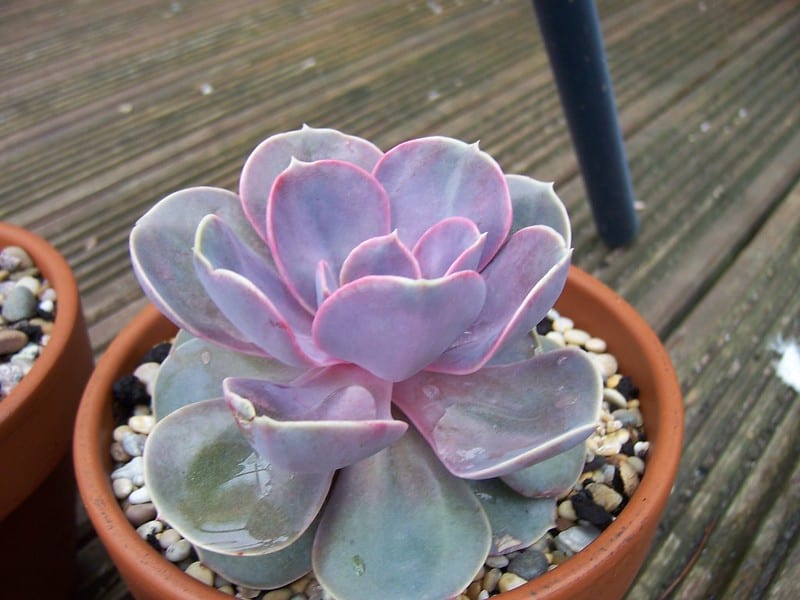The Echeveria “Perle Von Nurnberg” is a crop obtained by crossing two species of Echeveria (Echeveria gibbiflora x Echeveria potosina).
It is currently one of the largest crops distributed worldwide for its beauty and resistance.
This plant is characterized by forming a rosette of somewhat compact leaves supported by a small vertical stem.
It usually does not exceed 30 cm in height and its vertical growth is related to the lighting that its leaves receive, that is, greater lighting, less vertical growth.
The leaves have a very striking pink-grayish color where the pink color is mainly observed at the base of the leaves.
They are rounded with the acute apex by a small spine-shaped extension; It is not a thorn.
It can also be observed in older plants that the leaves tend to bend slightly in their central axis, that is, a concavity is observed in the beam.
Flowering (cluster inflorescences) occurs mainly in the spring and manifests itself with the formation of long floral stems that hold small leaves and flowers in their terminal region.
The flowers have the typical form of all Echeverias (they look like small lanterns) and have a pink-orange color.
Usually 1-3 inflorescences per plants are observed.
You may like zebra succulent
Tips to take care of the Echeveria Perle Von Nurnberg
This is one of the most resistant cultivators of the genus Echeveria that has been obtained and its cultivation is quite simple.
Here I leave your basic cultivation requirements:
Illumination
It needs to grow in very bright places although it tolerates growing in somewhat bleak places.
Anyway, it is recommended to place it in places with good lighting to keep the rosette low and avoid exaggerated growth of the stem.
Never expose it directly to the sun to avoid burns.
Temperature
Tolerates temperatures between 15-35 ° C as long as they remain stable over time.
Temperatures below 10 ° C can be fatal to the plant.
Substratum
It grows very well in a substrate for succulents and cacti plants although in a universal substrate with a little gravel and coarse sand it works very well.
Never use garden soil to avoid parasites or fungi.
Watering
Echeverias perle von nurnberg generally tolerate enough watering compared to other succulent plants. Water when the substrate is almost dry.
Avoid watering too much and the substrate is flooded because the plant rots.
Plagues and diseases
It is susceptible to attack by mealybugs and aphids.
It can also be severely damaged if it is reached by mollusks such as slugs and snails.
Excess watering causes root rot, avoiding excess.
Propagation
It is one of the easiest to reproduce Echeverias and its leaves emit roots very quickly.
It is multiplied by cuttings of leaves or stems.
Conclusion
Echeveria ‘Perle von Nürnberg’, is a hybrid of Echeveria gibbiflora v. Metallica and Echeveria potosina.
It is considered one of the most resistant cultivars of the genus Echeveria that have been obtained.
Its cultivation, also, is quite simple succulent.
The light will be decisive to keep the rosette low and prevent the stem from growing excessively.
The light will also be responsible for ensuring that pink tone on the almost bluish color of the leaves, which are rounded, with the sharp apex, which seems to extend in the form of a spine, although it is not a thorn.
The flowers, pink-orange, have the typical form (like small lanterns) of all of their genus and in each plant 1 to 3 inflorescences (sometimes up to 6) that appear during the spring or at the end of the summer.
Obviously, as with all succulents, we will have to monitor the frequency of irrigation, whose excess can be fatal.
In addition, we must take into account that in winter it is necessary to interrupt it (or water moderately).
In return, the Echeveria ‘Perle von Nürnberg” gives us one or several rosettes, 15 to 20 cm in diameter, which we can enjoy in a pot or in the garden, provided we provide a good substrate for succulents and cactus plants; or a universal substrate to which we will incorporate the corresponding drain.
